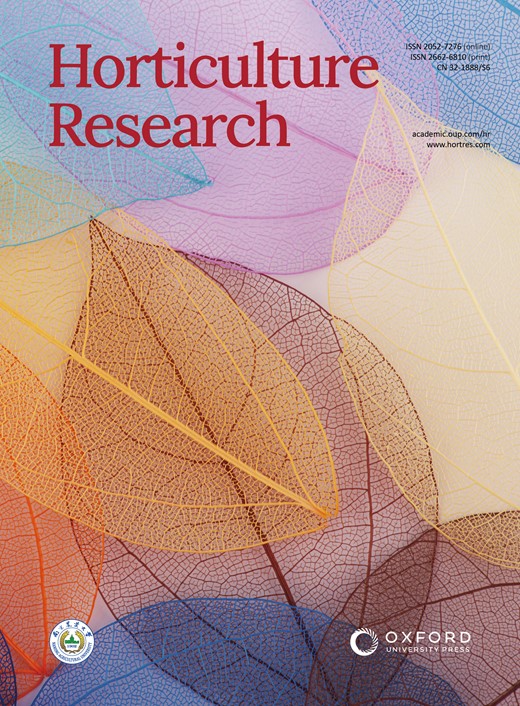BnSEP-BnTFL1s模块根据光照时数调控甘蓝型油菜的花序结构。
IF 8.5
1区 农林科学
Q1 Agricultural and Biological Sciences
引用次数: 0
摘要
具有确定花序(DTI)的油菜(Brassica napus L.)具有降低株高、增强抗倒伏能力和成熟一致性等优良性状,是一种有价值的育种资源。DTI由BnaA10调制。TFL1和BnaC09。TFL1 (BnaA10/C09.TFL1)编码TERMINAL FLOWER 1蛋白,是调控开花时间和分生组织特性的关键基因。然而,其潜在的功能和调控机制尚不清楚。在本研究中,我们证明了BnaA10/C09启动子区域的变化。甘蓝型油菜从不确定花序(IDTI)向不确定花序(DTI)转变的主要原因是TFL1,而不是编码区。具体来说,BnaA10。SEP抑制BnaA10/C09。通过结合BnaA10/C09启动子区gt1基序表达TFL1。TFL1DTI,促成了短日照条件下的IDTI表型。同时,通过同时敲除BnaA10/C09,成功产生了两个新的DTI突变体。TFL1使用CRISPR/Cas9系统。此外,BnaA10 / C09。TFL1及其同源物BnaA02。FT不直接与BnaA08结合,而是与BnaA07.14-3-3相互作用。FD调节不同花序结构的发育。总体而言,BnaA10.SEP-BnaA10 / C09.TFL1-BnaA07.14-3-3-BnaA08。FD模块揭示了甘蓝型油菜DTI形成的新机制和改良花序结构性状的新策略。本文章由计算机程序翻译,如有差异,请以英文原文为准。
The BnSEP-BnTFL1s module regulates inflorescence architecture based on light duration in Brassica napus L.
Rapeseed (Brassica napus L.) with determinate inflorescence (DTI) exhibit desirable traits, including reduced plant height, enhanced lodging resistance, and consistent maturity, making them valuable breeding resources. DTI is modulated by BnaA10.TFL1 and BnaC09.TFL1 (BnaA10/C09.TFL1) encode the TERMINAL FLOWER 1 protein, a key regulator of flowering time and meristem identity. However, the underlying functional and regulatory mechanisms remain unclear. In this study, we demonstrated that variations in the promoter region of BnaA10/C09.TFL1, rather than the coding region, contributed to the transition from indeterminate inflorescence (IDTI) to DTI in B. napus. Specifically, BnaA10.SEP inhibited BnaA10/C09.TFL1 expression by binding to the GT1-motif in the promoter region of BnaA10/C09.TFL1DTI, contributing to the IDTI phenotype under short-day conditions. Meanwhile, two novel DTI mutants were successfully generated through the simultaneous knockout of BnaA10/C09.TFL1 using the CRISPR/Cas9 system. Furthermore, BnaA10/C09.TFL1 and its homolog BnaA02.FT interacted with BnaA07.14-3-3 instead of directly binding to BnaA08.FD to regulate the development of different inflorescence architectures. Overall, the BnaA10.SEP–BnaA10/C09.TFL1–BnaA07.14-3-3–BnaA08.FD module revealed a new mechanism for DTI formation and a promising strategy for modifying inflorescence architecture traits in B. napus.
求助全文
通过发布文献求助,成功后即可免费获取论文全文。
去求助
来源期刊

Horticulture Research
Biochemistry, Genetics and Molecular Biology-Biochemistry
CiteScore
11.20
自引率
6.90%
发文量
367
审稿时长
20 weeks
期刊介绍:
Horticulture Research, an open access journal affiliated with Nanjing Agricultural University, has achieved the prestigious ranking of number one in the Horticulture category of the Journal Citation Reports ™ from Clarivate, 2022. As a leading publication in the field, the journal is dedicated to disseminating original research articles, comprehensive reviews, insightful perspectives, thought-provoking comments, and valuable correspondence articles and letters to the editor. Its scope encompasses all vital aspects of horticultural plants and disciplines, such as biotechnology, breeding, cellular and molecular biology, evolution, genetics, inter-species interactions, physiology, and the origination and domestication of crops.
 求助内容:
求助内容: 应助结果提醒方式:
应助结果提醒方式:


